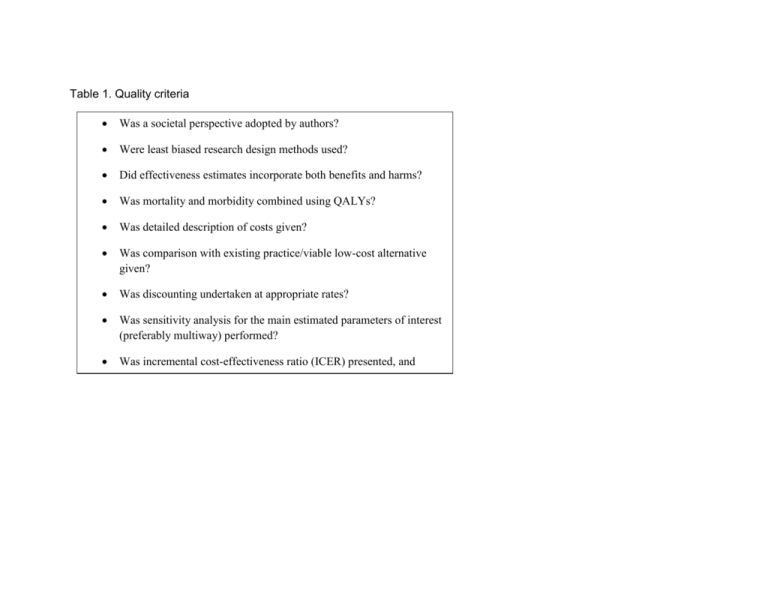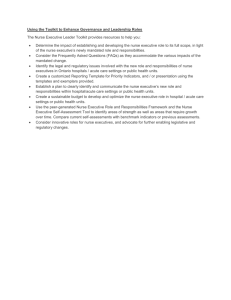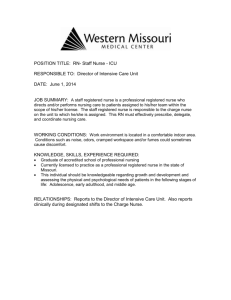specialists neonatal
advertisement

Table 1. Quality criteria Was a societal perspective adopted by authors? Were least biased research design methods used? Did effectiveness estimates incorporate both benefits and harms? Was mortality and morbidity combined using QALYs? Was detailed description of costs given? Was comparison with existing practice/viable low-cost alternative given? Was discounting undertaken at appropriate rates? Was sensitivity analysis for the main estimated parameters of interest (preferably multiway) performed? Was incremental cost-effectiveness ratio (ICER) presented, and compared with other appropriate interventions? Table 2) Skill mix studies Authors Location and medical area Bissinger et 36 bed al, 1997 neonatal intensive care unit, USA. Research Design; Participants Retrospective study of 2 matched groups of 70 critically ill, 24 months old infants. Intervention/ Control I: neonatal care received by 35 infants from neonatal nurse practitioners; C: neonatal care received by 35 infants from medical house staff Outcomes (costs and effectiveness) Quality of care, LOS, morbidity, mortality, composite quality of care index QI. Charges (proxy for cost of care) Cowan et al, 2006 Comparative, 2group, quasiexperimental design. 1,207 patients C: 626 patients in usual care management group Comparative, 2group, quasiexperimental design. 1,207 patients C: 626 patients in usual care management group I: 581 patients in NP group Effectiveness: LOS, Hospital mortality, and readmission 4 months after discharge Costs: hospital costs Effectiveness: as Hospital measured in Cowan (2006) study; quality of care. Costs: Intervention costs were compared to the difference in non-intervention costs. Ettner et al, 2006 USA, 610 bed tertiary hospital. USA, 610 bed tertiary hospital. I: 581 patients in NP group Perspecti ve Hospital Results No differences in LOS, morbidity, mortality. Per patient NNP charges usually lower for all categories of charges. Average LOS lower for patients in the experimental group. No significant differences in mortality or readmissions. Significantly lower costs in treatment group per patient. Intervention costs were $1187 per patient and associated with a significant $3331 reduction in nonintervention costs. Because health outcomes were comparable for the 2 groups, the intervention was considered cost-effective Gravely et al 1992 Three prenatal Non-experimental, care clinics, retrospective data; USA interviews. 156 participant women. Comparison between three staffing models explored: physician based; mixed staffing; clinical nurse specialists Griffiths et al, 2001 Intermediate RCT, 175 patients care patients in acute hospital wards (UK). I: nursing led inpatient unit (89 patients) with no routine medical intervention C: usual (consultantmanaged) units (87 patients) Mitchell et al 1997 Neonatal RCT, 821 patients intensive care, Canada I: 414 randomized to care by clinical nurse specialist/neonatal practitioner team C: 407 care by pediatric residence team Effectiveness: several neonatalmaternal physiological variables; Kessner index. Cost: total cost per patient visit Effectiveness: LOS, Barthel index Costs: direct healthcare costs (bottom-up; discounted bottomup; cost per bed day) Hospital No difference in health outcomes. Nurse-staffed clinic had the greatest satisfaction and lowest cost per visit and thus highest cost effectiveness (on this dimension). Hospital No effect on health outcome measures, but LOS longer for treatment group. Even though cost per patient day was lower for the treatment group, since LOS was longer for them, greater total patient costs in the treatment group. Effectiveness: Societal mortality; neonatal complications; length of stay; quality of care; longterm outcomes. Costs: Hospital cost per infant, plus family costs Fewer deaths in CNS/NP team; very little difference in costs and other outcomes. Overall, inconclusive evidence. Pioro et al, 2001 General medical ward in an academic teaching hospital in Midwestern USA RCT, 381 patients I: 193 patients treated by NPs and medical director C: 188 patients treated by medical house staff Effectiveness: LOS; complications; 30day mortality; patient assessments of care; changes in activities of daily living; symptom severity. Costs: hospital charges; costs (for specific departments only) Hospital Similar LOS, charges, inhospital complications. Similar health outcomes. Results similar in both intention to treat, and actual treatment analysis. No clear evidence of what is more CE. Pratt et al, 1993 Acute medical and acute surgical care in Australian hospital Retrospective study on the difference in costs and outcomes in 2 hospital wards. 393 acute medical and acute surgical care patients in Australian hospital Comparison of staffing patterns in two hospital wards staffed as follows: -all-RN staff -mix between 80% RN and 20% EN Effectiveness: subjective judgment of quality of nursing care by patients; correctness and accuracy of records; independent observation on quality of care Costs: daily/hourly costs of care per patient Hospital Little difference in patient outcomes. However, in the acute medical ward, RN staff was more expensive; in the acute surgical ward the staff mix was more costly. Overall, mixed evidence. Richardson et al, 2001 Intermediate RCT, 177 patients care patients in acute hospital wards (UK). I: 97 patients in nursing led inpatient unit with no routine medical intervention C: 80 patients in usual (consultant-managed) care units Effectiveness: Goldberg General Health Questionnaire (GHQ); Barthel index. Costs: consultations, drugs, cost per bed day. Post discharge cost data was included, but for 1 month only. Sakr et al, 2004 Accident and Emergency department, UK Comparison of care provided to 1447 patients in A&E department, and to 1315 nurse-led injury unit patients Effectiveness: Provider process errors; waiting times Costs: Per minor injury case. For estimating total costs, both workload unit (i.e., patient costs), and follow-up costs of treatment were included. Before after cohort study: nurse-led minor injury unit replacing A&E department. 2,762 patients Payer No effect on health outcome measures, but LOS longer for treatment group. Greater total costs in the experimental group. However, the post discharge costs were significantly lower for the treatment group. If maintained for 5 to 10 months, it could cancel out greater hospital costs for this group. Significantly fewer process errors and better waiting times at nurse-led units. However, costs were greater at nurse units. No formal ICER ratios derived. Taylor et al, 1997 Anticoagulant service, USA Sequential retrospective study, 2 hospital sites in the UK. Patients divided into 2 groups: A (newly referred) and B (randomly identified). 430 patients altogether In groups A and B, further comparison between patients treated in nurse specialist care and consultant care was made Effectiveness: mean proportion of time patients spent on therapeutic range; number of adverse dug interactions; patient satisfaction with service provision. Cost: total treatment-related costs. Provider No difference in total costs between 2 clinics. No difference in time patients spent in therapeutic range, but greater satisfaction of patients in the treatment group. Venning et al, 2000 Primary care centers, UK RCT, 1,303 patients Comparison between care provided by nurse practitioners (n=641) and by GP consultants (n=651). Effectiveness: patient satisfaction, health status. Costs: visit costs Provider No difference in health outcomes and in health service costs; greater patient satisfaction for nurses. Costs were similar because of longer consultation times, tests and return times for nurse-provided care. Table 3) Nurse staffing studies Authors Dall et al, 2009 Ganz et al 2005 Needleman et al, 2006 Location and Research medical area Design/Participa nts USA, Regression nonfederal analysis and acute care literature review hospitals of hospital discharge data from the 2005 Nationwide Inpatient Sample. Intervention/ Control Staffing variable: RN hours per patient day. Outcomes (costs and effectiveness) Effects: Savings from avoided, nosocomial complications, shorter LOS, greater national productivity. Costs: annual cost of employing a nurse Skilled Markov cohort Comparison between Effectiveness: life nursing simulation of median staffing level for expectancy, qualityfacilities for recommended vs registered nurses, licensed adjusted life post-acute median staffing staff and nurse assistants expectancy. Costs: care, USA Post acute care and recommended staffing hospital costs. patients level for them Nursing costs aggregated per patient day Acute general Regression 3 options compared: Effectiveness: care hospitals, analysis of -raise proportion of RN to avoided death; USA observational data 75 percentile, without avoided adverse from 799 change in licensed hours; outcomes; LOS hospitals, with -raise number of licensed Costs: both short 5,075,969 medical hours to 75 percentile, and long term and 1,104,659 without change in hospital, per patient Perspecti ve Results Societal As nurse staffing levels increase, patient risk of nosocomial complications and hospital length of stay decrease, resulting in medical cost savings. Diminishing effect at higher levels. ICER of recommended versus median staffing was $321,000 per discounted qualityadjusted life year gained. Insurer Provider Most cost-effective option appears is to raise the proportion of RNs without changing licensed hours. Decreases in urinary tract infections, surgical discharges Rothberg et al, 2005 General medical and surgical care, USA Analysis of observational data from literature, and from 2 large hospital studies General medical and surgical patients Rothschild et al, 2009 Two critical care coronary units in New England, USA Regression analysis of observational data Critical care patients proportion of RN staff; -Raise both to 75 percentile costs modeled pneumonia, and shock or cardiac arrest are associated the most with increasing the proportion of RNs. Comparison of ICERs for Effects: mortality; Institution 8:1 ratio was the least patient to nurse ratios LOS. al expensive, but ranging from 8:1 to 4:1 Costs: Nursing cost associated with the per patient. highest patient mortality. Smaller ratios improved mortality and increased costs, becoming progressively less cost-effective. However, ICER never exceeded 136,000/life saved. Comparison of the savings Effects: cost savings Hospital Marginal nurse from averting adverse from avoiding staffing costs under events for various critical adverse events. higher staff levels care nurse staffing levels Costs: Nurse staffing were smaller than the (1:1, 1:2, 1:3) costs expected cost savings from prevented adverse events (AEs).








